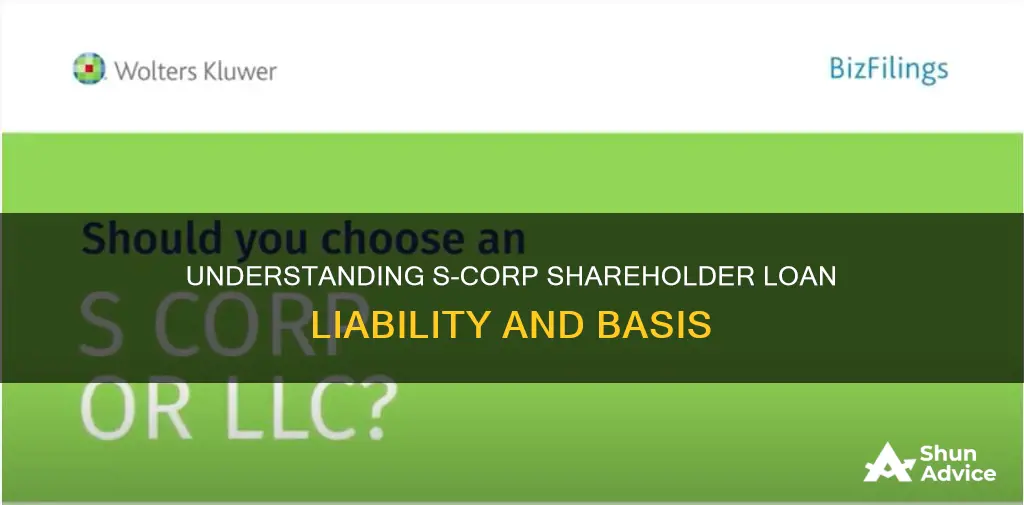
Understanding the concept of basis is crucial for shareholders in S corporations as it directly impacts their ability to use losses that pass through from the company. Basis refers to the amount of investment a shareholder has in the business and is influenced by factors such as the original purchase of stock, additional equity contributions, and cumulative net income. One aspect that affects basis is shareholder loans to the S corporation. When a shareholder lends money directly to the S corporation, they acquire debt basis. However, it is important to distinguish between a loan guarantee and a bona fide debt, as only the latter increases shareholder basis. Courts evaluate the financial condition of the S corporation and the intent of the parties involved to determine the existence of a valid debtor-creditor relationship. Shareholders should carefully structure loans to maximize deductible passthrough losses and lower their tax liability.
What You'll Learn

Shareholder loan guarantees
A shareholder loan agreement is a contractual agreement that summarises the terms and conditions of a loan made by a shareholder to a business. It is an arrangement that guarantees the loan is lawfully binding and helps safeguard the interests of both parties. The agreement should clearly state the terms of repayment, interest rates, and other relevant details to avoid future misinterpretations or conflicts.
Shareholder loans can have tax implications for both the shareholder and the company, so it is essential to consult a tax professional to determine the loan's tax implications and how to structure the agreement to minimise them. For example, in the US, an S corporation's profits and losses are passed through to its shareholders and reported on their returns. While all profits are considered income to the shareholders, deductions and losses are attributable to the shareholders only insofar as they do not exceed the shareholders' adjusted basis in the stock of the S corporation and the indebtedness of the S corporation to the shareholders.
In the US, prior to the issuance of the debt basis regulations in 2014, courts applied the "actual economic outlay" test to determine whether a debt created debt basis in an S corporation for an S corporation shareholder. However, the debt basis regulations replaced this test with the "bona fide indebtedness" test. This test is set out in Regs. Sec. 1.1366-2(a)(2)(i), which states that the term basis of any indebtedness of the S corporation to the shareholder means the shareholder's adjusted basis in any bona fide indebtedness of the S corporation that runs directly to the shareholder.
In the case of Hargis v. Commissioner, the Eighth Circuit affirmed a Tax Court ruling that held that a shareholder's guarantee of a loan to an S corporation was not an actual economic outlay and therefore did not increase the shareholder's debt basis in the S corporation. The Tax Court found that since the loans were made directly to the S corporations and the proceeds and payments never touched Hargis's personal account, he had the potential for liability but not an actual liability.
In summary, a loan guarantee by a shareholder of an S corporation may increase their basis if the shareholder has borrowed funds and subsequently advanced them to the S corporation. However, a shareholder's guarantee of a loan to an S corporation is generally not considered an actual economic outlay and does not increase the shareholder's debt basis.
Recourse Loans: Impact on Partnership Basis
You may want to see also

Bona fide debt
The definition of bona fide debt is clearer when the source of funds is an unrelated third party, such as a bank. In this case, the shareholder borrows funds from the bank and then lends them to the S-corporation. The bank holds the shareholder responsible for repayment. However, when the loan is between related parties or entities with common ownership, establishing bona fide debt becomes more complex. In these situations, it is crucial to document the intent of the parties, characterizing the transaction as a loan in corporate resolutions and accounting records.
Courts evaluate the financial condition of the S-corporation debtor at the time the loan was made to determine if the shareholder had a reasonable expectation of repayment and the intent to enforce collection. They also consider whether the shareholder collateralized the loan with their personal property. A history of principal and interest payments further supports the existence of bona fide debt.
The IRS has issued regulations clarifying when S-corporation shareholders can increase their adjusted basis due to indebtedness by the corporation. According to these regulations, shareholders may only increase their adjusted basis if the indebtedness is bona fide. This change aims to prevent certain tax strategies while assisting shareholders in understanding their arrangements with the S-corporation.
Additionally, it is important to note that a loan guarantee is not sufficient to increase a shareholder's debt basis. The shareholder must have personally lent money to the S-corporation, demonstrating their financial ability to do so. These regulations highlight the significance of understanding S-corporation basis rules, which enable shareholders to maximize deductible pass-through losses and minimize their tax liability.
How Realtors Can Help Secure Your Dream Home Loan
You may want to see also

Loan structuring
Understanding Bona Fide Debt
The concept of "bona fide debt" is central to loan structuring in the context of S corporations. Bona fide debt refers to a valid and enforceable obligation between a debtor and a creditor, involving a fixed or determinable amount of money. The IRS and courts examine several factors to determine if a loan qualifies as bona fide debt, including the presence of a fixed repayment schedule, collateral, and a history of principal and interest payments.
Shareholder as the Primary Obligor
To establish an S corporation basis, it is advisable for the shareholder to be the primary obligor on the loan, with the S corporation as the guarantor. This structure ensures that the shareholder is directly responsible for repayment, enhancing the legitimacy of the loan.
Back-to-Back Loan Structure
A back-to-back loan structure involves the bank distributing loan proceeds directly to the shareholder, who then lends the funds to the S corporation. This approach clearly demonstrates the lender's intention to make the loan to the shareholder, strengthening the argument for a bona fide debt.
Circular Loans
While circular loans, where funds are loaned between related parties, were once viewed with skepticism, the current regulatory environment allows for their use in creating S corporation debt basis. Careful structuring, including terms similar to those between third parties and collateralization, can enhance the legitimacy of circular loans.
Loan Documentation and Timing
Proper documentation is essential to substantiate the loan's purpose, repayment terms, and interest accrued, and the relationship between the parties. Inadequate documentation may result in the IRS reclassifying the loan as a dividend or compensation, leading to unexpected tax liabilities for the shareholder. Additionally, the timing of loan repayments is critical, as repayments exceeding the shareholder's basis may be taxed as income or capital gains.
Loan Guarantees
It is important to note that a loan guarantee alone does not increase a shareholder's debt basis in the S corporation. To establish basis, the shareholder must demonstrate an actual economic outlay, such as personally lending funds to the S corporation.
By carefully considering these loan structuring strategies, shareholders can maximize deductible passthrough losses, lower their tax liability, and unlock valuable tax planning benefits associated with S corporations.
PSLF Covers Only Federal Loans, Not Private Ones
You may want to see also

Basis adjustments
There are two main types of basis in an S corporation: stock basis and debt basis. Stock basis is typically increased through the original purchase of stock, additional equity contributions, and cumulative net income. It is decreased by items of loss and deduction, as well as nondividend distributions (distributions other than from accumulated earnings and profits).
Debt basis, on the other hand, is acquired through loans made by the shareholder to the S corporation. It is important to note that loan guarantees do not increase debt basis, as they do not constitute an actual economic outlay by the shareholder. Only when a shareholder has personally lent money to the S corporation can they claim debt basis. Debt basis is also computed similarly to stock basis but with some differences.
To maximize deductible passthrough losses and lower shareholder tax liability, careful loan structuring is required. This involves ensuring that the loan meets the definition of a bona fide debt, with a fixed schedule for repayment and collateralization. Courts will evaluate the financial condition of the S corporation and the intent to create a valid debtor-creditor relationship when determining the existence of a bona fide debt.
Loan Advisor Meetings: Realtors' Presence and Their Importance
You may want to see also

Tax implications
Shareholders in S corporations are only taxed on their share of the profits and losses, which are passed through to their personal tax returns. This is one of the main reasons for electing S corporation status. Shareholders acquire S corporation basis through the original purchase of stock, additional equity contributions, and cumulative net income, less distributions passed through to the shareholder during the time the stock is owned.
Shareholders can also acquire debt basis from loans made to the S corporation. This is important because it is the first test to determine whether the shareholder has a deductible loss from the company. A shareholder is only allowed debt basis to the extent that they have personally lent money to the S corporation. A loan guarantee is not sufficient to allow the shareholder debt basis. If a shareholder sells their stock, suspended losses due to basis limitations are lost.
The IRS has specific regulations around what constitutes a "bona fide debt" and these must be respected to ensure the loan is considered a debt basis. The definition of bona fide debt is met without a doubt when the source of the funds is an unrelated third party, such as a bank. If the shareholder borrows funds from a bank and lends the cash to the S corporation, the bank will hold the shareholder to repayment terms. When the loan is made between related parties, it is important to document the intent of the parties by characterizing the transaction as a loan in the corporate resolutions and accounting records. The parties should maintain written notes with a fixed repayment schedule and a fair market rate of interest at a federal rate.
Courts will evaluate the financial condition of the S corporation debtor when the loan was made to ensure it supports an expectation of repayment on the part of the shareholder and an intent to create a valid debtor-creditor relationship. The courts have also found it important that the shareholder collateralize the loan with their personal property.
Non-dividend distributions to the shareholder are generally tax-free as long as the distribution is not over the stock basis of the shareholder. If the distribution exceeds the amount of stock basis, the excess distribution will be taxed as a capital gain. If the stock was held for more than a year, the capital gain is a long-term gain; otherwise, it will be taxed as a short-term capital gain.
Laptop Loans: Richland Library's Lending Service Explored
You may want to see also
Frequently asked questions
An S corporation is a corporation with a valid "S" election in effect. The impact of the election is that the S corporation's items of income, loss, deductions and credits flow to the shareholder and are taxed on the shareholder's personal return.
Basis refers to the amount of investment the taxpayer has in the business. A shareholder acquires S corporation basis through the original purchase of stock, additional equity contributions, and cumulative net income, less distributions passed through to the shareholder during the time the stock is owned.
A shareholder acquires debt basis from loans made directly to the S corporation. The loan must be considered bona fide debt, with a fixed repayment schedule and a fair market rate of interest.







